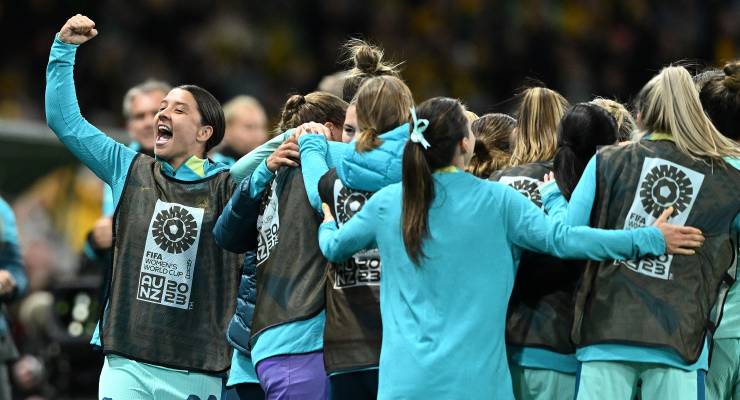
For a split second, there is silence after the number flashes up on screen: 75,784. Then comes the roar as every member of the crowd there to witness the Matildas play their opening FIFA Women’s World Cup game lifts their hands in celebration. They have made history as the biggest crowd for the women’s national football team.
With the Matildas set to take on Denmark in their round of 16 match on Monday night, the nation stands behind them. A nation that kept believing after a shaky win over Ireland and a disheartening loss to Nigeria was rewarded with a dominant win over Olympic champions Canada and a place at the top of their group. Whether they can advance from here is yet to be seen, but they have already won the hearts and minds of the country.
While women’s sport in Australia has come a long way, with established AFLW, NRLW, football, cricket, netball and basketball competitions, there have remained fewer media stories, less promotion of games and — as a result — lower crowds in smaller stadiums for Australia’s elite female teams compared to their male counterparts.
In March 2020, when a crowd of 86,174 flocked to the Melbourne Cricket Ground for the final of the Women’s T20 Cricket World Cup, it seemed like a moment in time, one that would truly change the game for women’s sport. But shortly after, the pandemic shut the world down and the opportunity to build on that momentum was lost. While the foundations remained, a lot of rebuilding was required and finally, more than three years later, those same heights are being reached with another World Cup in Australia’s backyard.
The next two weeks will be full of celebration and excitement. Regardless of whether or not the Matildas are there in the final at Stadium Australia on August 20, the crowd will be immense and the eyes of the world will be watching. But when the teams go home and the colourful signage is packed away, what happens next? What will be the enduring legacy of this World Cup?
There are some important lessons that can be learnt from the success of this tournament — not just for women’s football, but for women’s sport more broadly. The first one is that crowds matter. For so long in women’s sport there has not been a strong focus from administrators on getting big crowds, with smaller venues preferred and broadcast viewers prioritised. But when the lockdowns of 2020 removed crowds from men’s sport, it became very clear how important they were in creating an atmosphere to lift performance and make a better broadcast product. The swell of packed stadiums throughout this tournament has provided another demonstration of their influence.
Sporting organisations across the country can take confidence from the success of the World Cup and make bold scheduling decisions — something we have already seen with the Women’s Big Bash League set to play standalone games at the Melbourne Cricket Ground and Sydney Cricket Ground for the first time this year. Making those decisions forces action to fill bigger stadiums and once the crowds are there, they will come back for more.
The second lesson is that women’s sport is for everyone. Rather than focusing on existing fans of men’s sport or marketing directly to children, as has long been the accepted wisdom in women’s sport, administrators can look at the diversity of fans flocking through the gates of this tournament. Groups of friends, families, couples, work colleagues and sporting teams are all getting together to go along to a game. The presentation of the matches reflects this diverse crowd, with music, food, drinks and entertainment that cater to everyone who walks through the gates. It is about recognising and welcoming everyone and understanding that a wider net can be cast when drawing in new fans.
Finally, we have learnt that brands should have no misgivings about investing in women’s sport. It is no longer simply about female athletes being role models or aligning with the values of a brand — though these factors are still important. This tournament has demonstrated that it is also incredibly commercially savvy to get on the women’s sport bandwagon. Before the World Cup even began, Matildas jerseys had outsold Socceroos jerseys for the men’s World Cup the year previously and Nike Pacific boss Ashley Reade believed the marketing potential for the women’s team had already passed the men’s team.
Recently Victorian government agency Change Our Game reported findings that for every $1 a corporate sponsor invests in women’s sport, they see an average return of $7.29 in customer value. More money being funnelled into women’s sport will drive greater professionalism and an increased standard of competition, leading to more fans and bigger crowds. The time for brands to recognise this opportunity is upon us.
Women’s sport no longer sits at the margins of the sporting landscape; it is not a niche interest. The fires of passion are burning and will not be extinguished. The future that athletes, administrators and fans have been fighting for is here.
Are you getting behind the Matildas? What needs to happen in order for women’s sport to continue to flourish? Let us know your thoughts by writing to letters@crikey.com.au. Please include your full name to be considered for publication. We reserve the right to edit for length and clarity.








I am still pinching myself about being in the 75,784 crowd. And then I remember I was watching a Women’s sporting match and I am still getting my head around what that actually means. And then the I remember the amount of kids, especially young boys, watching on and knowing the names of female athletes. And then I think, is this the first generation of young girls and boys who will grow up thinking that men and women are truly equal?
A couple of other key points that I think are worth considering:
Go the Matildas.
Unbelievable tournament.
So proud to see the Matilda scores on news sites around the globe. Shout out to the commentators for their excellent kick-by-kick analysis and interesting context to help make this an exceptional cultural experience.
I agree with a lot of this, especially your argument about bigger crowds creating an atmosphere – it’s just a shame that Aussie sports administrators don’t make the connection between big crowds and atmosphere, or don’t really care – rectangular pitched games (rugby, football ) should never be played in round stadiums – MCG, Optus etc. Yes you get extra bums on seats but you absolutely lose atmosphere due to being 50m or more away from the touch line. A half full Suncorp will always trump a full MCG when it comes to atmosphere.
to take a contrary view, the old adage is tat it s better to sel out a small venue than to have a half empty full venue.
35000 people at the MCG would have nowhere near the atmoshphere as the same crowd at the Melbourne Rectangular Stadium across the train line on Olympic Blvd (even before talking about round vs rectangular crowd dynamics).
The key point is to match the venue capacity with the anticipated crowd to minimise the number of empty seats visible to the TV audience.
Agree, it’s why there is a better fit with football and NRL in purpose built stadia vs. feuding over ovals by AFL and cricket.
The MCG can mean being upper decks, where a wag suggested a need for free binoculars vs. another asking about oxygen tanks….
Support Denis Johnson on this. Our major cricket/AFL venues are duds as far as I’m concerned for watching any code of football other than the Sherrinball. Perth has one rectangular stadium that’s ok, Melbourne one that’s better, Adelaide’s Hindmarsh is very small, Canberra’s primitive, nothing in Hobart. So, until we get some decent rectangular fields outside the Sydney/Brisbane ones, the rest of Australia may feel a little disengaged.
I disagree that the current WWC makes the case for equal pay in sports.
I think the Matildas should be paid much more then their men’s equivalent, the latter of whom show little loyalty to the domestic game while consistently failing to perform once summoned for the national team.
This is certainly the case in Australia, but not globally. Women do not deserve equal pay to men in most sports. If they did, then the separation of sport by gender should be abandoned and men and women be eligible to play together.
Why on earth would more equality in salary mean the men and women should start playing each other?
Seriously? The women are just as ‘disloyal’ as the men, more and more of them getting good gigs at European, Asian and US clubs. Creating so many players good enough for national teams and for foreign clubs is a success of the local game. And I seem to remember that the Socceroos also made the last 16 in their World Cup last year, a big achievement in so competitive a sport. Hopefully the Tillies will go one better tonight.
Agree. One thinks the article misses important aspects apart from women’s sport, i.e. football as a game is not limited like AFL, NRL or cricket to local, Anglosphere &/or Commonwealth, while any national player acts as an ambassador for Australia when playing offshore club level and gaining media coverage whether Europe or Asia.
The offshore reach of many matches in the Asian Cup hosted in Oz several years ago (but not so much Vic….), was according to Telstra, approaching 800 million…..
Where do you get this idea on the men from ‘the latter of whom show little loyalty to the domestic game’?
What does it even mean?